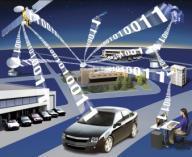Wireless Connectivity to the Automobile is Hindered by Lack of Standards and Interoperability, Says ABI Research
 |
NEW YORK--Satellite radio, WiMAX, Wi-Fi, various flavors of DMB, HD radio, cellular, and Bluetooth: the tech-savvy motorist is confronted by such a bewildering array of frequently incompatible technologies for getting infotainment content to and from the vehicle, that the simple act of listening or watching can become a serious challenge. And with new technologies gathering steam in the market, this challenge is likely only to get worse in the next few years. To ensure future growth, according to a recent report from ABI Research, key players in the in-vehicle infotainment market need to settle down and produce solutions that are both easy to use and compatible.
“One of the challenges is that there are too many competing types of connectivity,” says research director Mike Ippoliti. “Some technologies are good for some things, some are good for others; most don’t ‘talk’ to each other. Customers are used to the entertainment setups they have at home, and will frequently opt for the simplest solution. That’s certainly the case with Bluetooth: many Bluetooth-equipped phones won’t connect to automotive systems, and many Bluetooth profiles may or may not work depending on a number of factors.”
In many tech sectors, the solution would be clear: uniform standards. But although the Bluetooth SIG is taking steps to make the Bluetooth standard more consistent, incompatible Bluetooth implementations still hamper uptake. “They have a way to go,” says Ippoliti, “before it becomes sufficiently easy for the consumer that the automotive OEMs will start accepting this kind of wireless connectivity in the car. Right now the OEMs are resisting, and consumers frequently prefer wired connections instead.”
Supporting that assessment, a recent ABI Research study found that annual OEM shipments of Bluetooth kits will only double to just over 9 million between now and the end of 2012, whereas OEM shipments of head units with (wired) USB ports will increase more than six-fold, to nearly 11 million, in the same period.
ABI Research’s study, In-Vehicle Infotainment Storage and Networking (http://www.abiresearch.com/products/market_research/In-Vehicle_Infota inment_Storage_and_Networking)(Due to its length, this URL may need to be copied/pasted into your Internet browser's address field. Remove the extra space if one exists.), considers storage formats, wired connectivity such as USB, iPod kits, and flash memory slots, wireless connectivity such as Bluetooth and UWB, and even long-range wireless distribution such as cellular networks and digital terrestrial and satellite radio. It examines the acceptance and potential for these technologies in factory automotive production. The research analyzes OEM infotainment strategies, and provides forecasts through 2012.
It forms part of two subscription Research Services: the Automotive Electronics Research Service (http://www.abiresearch.com/products/service/Automotive_Infotainment_R esearch_Service) (Due to its length, this URL may need to be copied/pasted into your Internet browser's address field. Remove the extra space if one exists.)and the Automotive Infotainment Research Service (http://www.abiresearch.com/products/service/Automotive_Electronics_Re search_Service) (Due to its length, this URL may need to be copied/pasted into your Internet browser's address field. Remove the extra space if one exists.).
Founded in 1990 and headquartered in New York, ABI Research maintains global operations supporting annual research programs, intelligence services and market reports in broadband and multimedia, RFID & contactless, M2M, wireless connectivity, mobile wireless, transportation, and emerging technologies. For information visit www.abiresearch.com, or call +1.516.624.2500.


